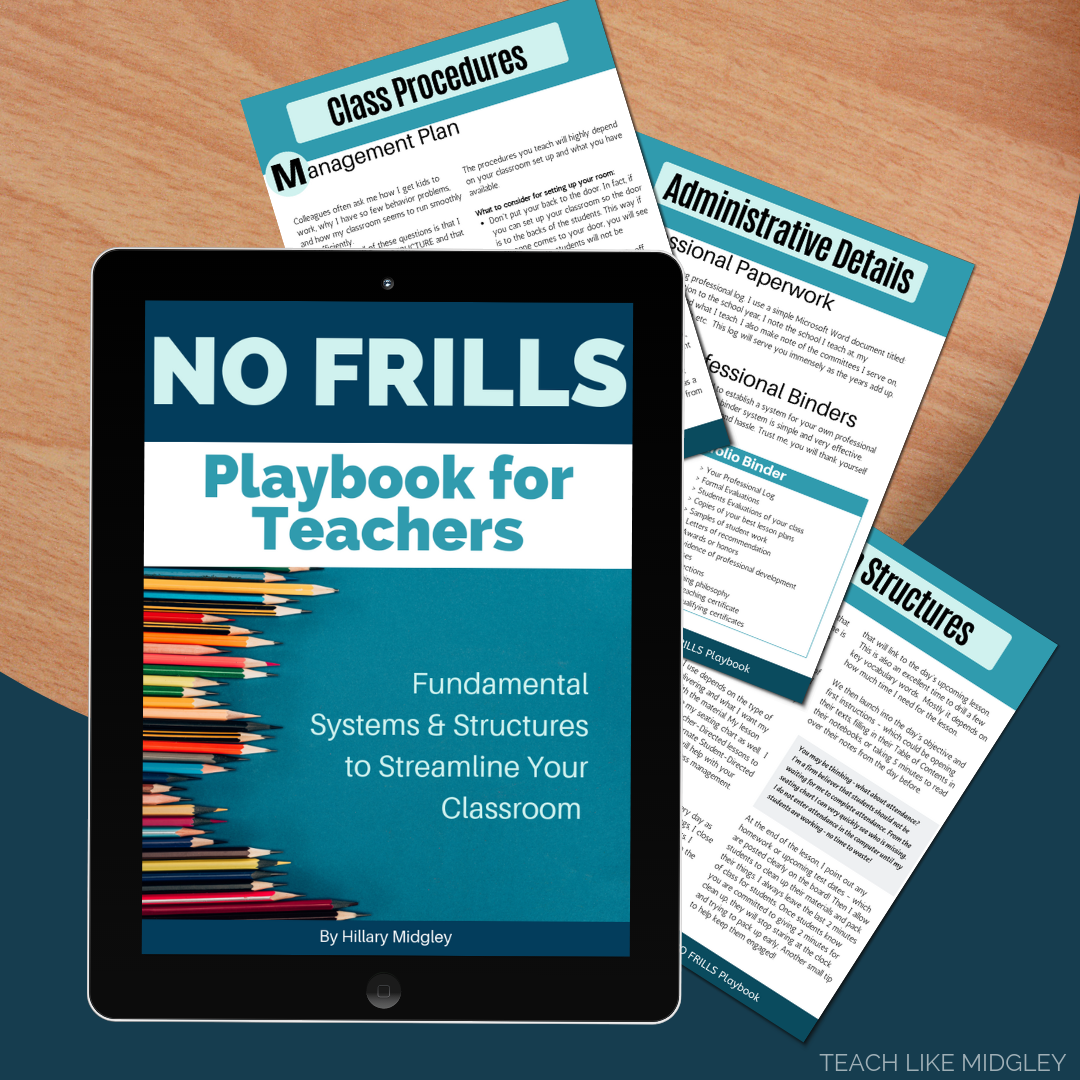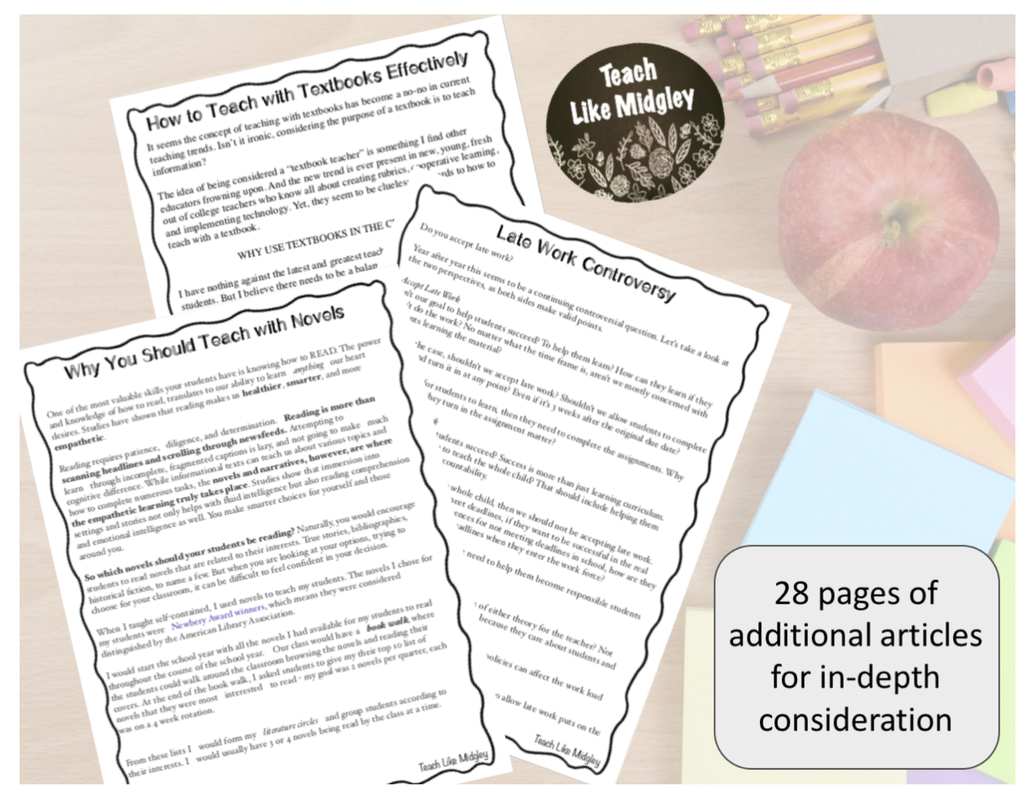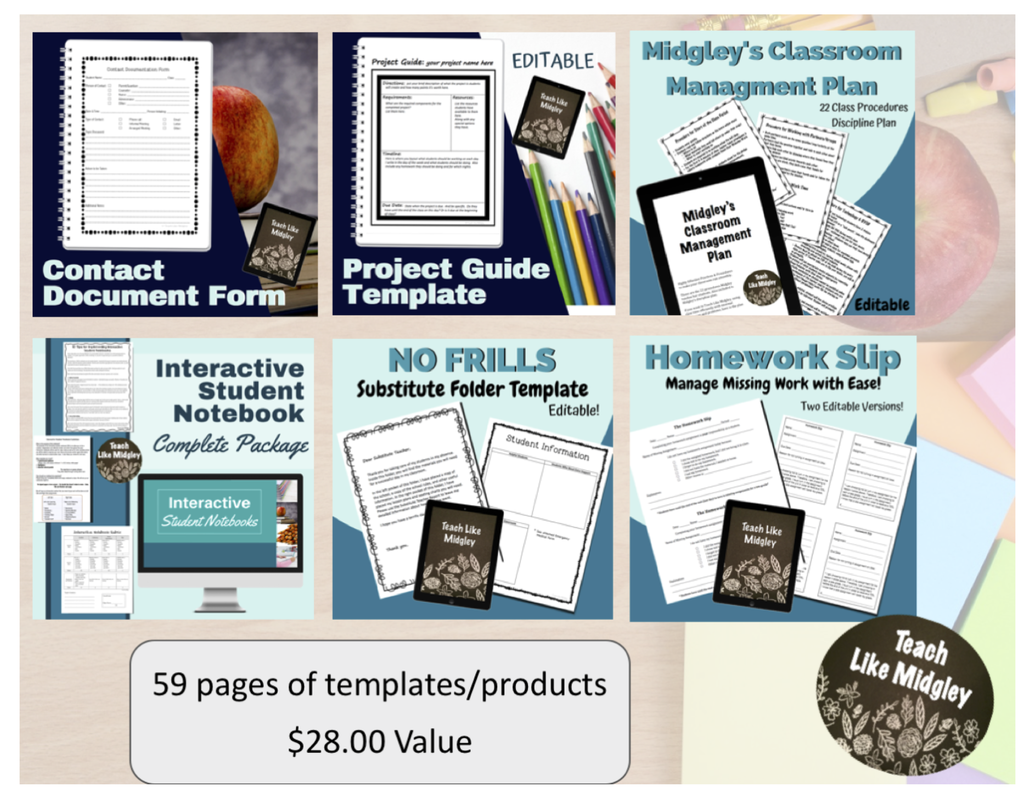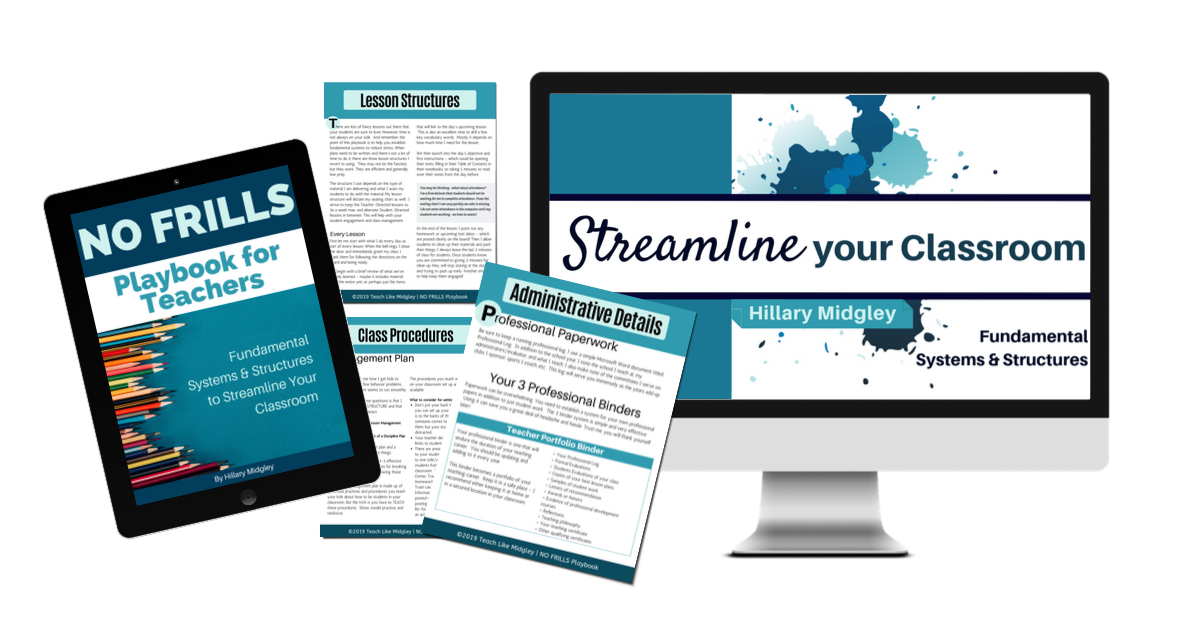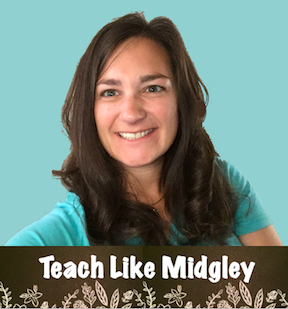NO FRILLS
|
The day I accepted my first teaching job, I was terrified. I had completed my student teaching and had even done some substitute teaching. But none of it prepared me. Not for what I was really getting into.
I accepted a job as a 6th grade teacher. I had never even stepped foot into a 6th grade classroom before. I knew nothing about the curriculum. I knew nothing about the students.
To sum it up, I knew nothing.
I jumped in feet first, right in the middle of the school year. I was hired to replace a teacher who was pregnant. And I was taking over half way through the school year.
That first year – or half a year – was a real challenge for me. I had no mentor or even curriculum guides for that matter. I had to develop most of my materials on my own.
But curriculum aside, I had absolutely no idea just how important it was to have systems and structures.
Systems for students. Systems for materials. Systems for myself.
My first few years teaching I felt like I was in a fog, just trying to feel my way around and somehow find time to do everything that needed doing.
Thanks to my determined nature, I didn’t give up. Over the years I’ve spent hours developing systems to implement into my classroom and daily life as a teacher.
Changing schools, classrooms, and subject areas forces you to adjust, even sometimes adjust those systems that you really like.
Maybe you know the feeling? Maybe you can relate to being juggled to another school, subject area or another grade level. And it feels like your first year teaching all over again.
So much to figure out. Curriculum, supplies, students, family communication, administrative expectations, and on and on.
Maybe you have been teaching in the primary grades and now suddenly you’re being thrown into the intermediate world. Welcome to a whole new world of grading.
How is one teacher supposed to handle it all? Especially when as a new teacher you don’t even know what all you’re supposed to handle?
The past several years I’ve established a bit of a reputation for myself as being the teacher who is always ready and who always has a classroom of students working.
I attribute this reputation to the systems and structures I implement in my classroom and the procedures I teach to my students.
Now I am so thrilled to be able to share with you, all that I’ve learned. And how you too can implement systems into your classroom and see just as much success.
I accepted a job as a 6th grade teacher. I had never even stepped foot into a 6th grade classroom before. I knew nothing about the curriculum. I knew nothing about the students.
To sum it up, I knew nothing.
I jumped in feet first, right in the middle of the school year. I was hired to replace a teacher who was pregnant. And I was taking over half way through the school year.
That first year – or half a year – was a real challenge for me. I had no mentor or even curriculum guides for that matter. I had to develop most of my materials on my own.
But curriculum aside, I had absolutely no idea just how important it was to have systems and structures.
Systems for students. Systems for materials. Systems for myself.
My first few years teaching I felt like I was in a fog, just trying to feel my way around and somehow find time to do everything that needed doing.
Thanks to my determined nature, I didn’t give up. Over the years I’ve spent hours developing systems to implement into my classroom and daily life as a teacher.
Changing schools, classrooms, and subject areas forces you to adjust, even sometimes adjust those systems that you really like.
Maybe you know the feeling? Maybe you can relate to being juggled to another school, subject area or another grade level. And it feels like your first year teaching all over again.
So much to figure out. Curriculum, supplies, students, family communication, administrative expectations, and on and on.
Maybe you have been teaching in the primary grades and now suddenly you’re being thrown into the intermediate world. Welcome to a whole new world of grading.
How is one teacher supposed to handle it all? Especially when as a new teacher you don’t even know what all you’re supposed to handle?
The past several years I’ve established a bit of a reputation for myself as being the teacher who is always ready and who always has a classroom of students working.
I attribute this reputation to the systems and structures I implement in my classroom and the procedures I teach to my students.
Now I am so thrilled to be able to share with you, all that I’ve learned. And how you too can implement systems into your classroom and see just as much success.
Benefits of the NO FRILLS Playbook
No more worries that you’re missing something – know exactly what questions you need to ask to get the information you need.
Brand new to teaching? I’ve got you covered with all the fundamentals you need to establish a strong classroom structure with systems and procedures that will work for you and your students.
Changing grade levels and don’t know where to start? Simplify your school year with a plan of attack using the structures in this playbook.
Feeling like the overwhelmed teacher? Leave the frills behind and let me show you the basic systems you need to make your classroom run smoothly and allow you to reclaim your weekends.
And so much more...
Brand new to teaching? I’ve got you covered with all the fundamentals you need to establish a strong classroom structure with systems and procedures that will work for you and your students.
Changing grade levels and don’t know where to start? Simplify your school year with a plan of attack using the structures in this playbook.
Feeling like the overwhelmed teacher? Leave the frills behind and let me show you the basic systems you need to make your classroom run smoothly and allow you to reclaim your weekends.
And so much more...
What You Get When You Purchase
the NO FRILLS Playbook:
A 63 page e-book that explains the fundamental systems and structures you need to streamline the function of your classroom.
Topics Include:
Curriculum Planning
Unit Structures
Classroom Policies
Rules, Rewards & Recognitions
Student Papers & Seating
Lesson Structures
Writing Lesson Plans
Administrative Details
The Syllabus
Teacher Work Space
Routines for Teacher Life Balance
When to Add the Frills
Topics Include:
Curriculum Planning
Unit Structures
Classroom Policies
Rules, Rewards & Recognitions
Student Papers & Seating
Lesson Structures
Writing Lesson Plans
Administrative Details
The Syllabus
Teacher Work Space
Routines for Teacher Life Balance
When to Add the Frills
Frequently Asked Questions
Who is this Playbook for?
You will get the most out of this book if you are teaching grades 4-8. Whether you are a new teacher, a teacher changing grade levels, subjects, or schools, or a teacher looking to streamline your classroom so you can reclaim your weekends. This playbook is for you.
Is this Playbook for New Teachers? Yes! It absolutely is – no more guessing and wondering what to do next. No more feeling helpless or lost!
I’m tired of so much wasted time in my classroom. Can this Playbook help me? Yes! It certainly can! This Playbook can help you establish procedures so your students will know exactly what is expected of them and allow you to get more accomplished.
I’m frustrated with all the student papers. How can I manage them? The NO FRILLS Playbook for teachers has easy to implement systems to help you tackle the paper fiasco that surrounds us as teachers.
You will get the most out of this book if you are teaching grades 4-8. Whether you are a new teacher, a teacher changing grade levels, subjects, or schools, or a teacher looking to streamline your classroom so you can reclaim your weekends. This playbook is for you.
Is this Playbook for New Teachers? Yes! It absolutely is – no more guessing and wondering what to do next. No more feeling helpless or lost!
I’m tired of so much wasted time in my classroom. Can this Playbook help me? Yes! It certainly can! This Playbook can help you establish procedures so your students will know exactly what is expected of them and allow you to get more accomplished.
I’m frustrated with all the student papers. How can I manage them? The NO FRILLS Playbook for teachers has easy to implement systems to help you tackle the paper fiasco that surrounds us as teachers.
Don't Forget the Bonuses!
|
AND links to 59 pages of Templates and Products to help you implement these structures and systems – A $28 value
Yearly Planning Template Interactive Student Notebook Complete Implementation Package The Homework Slip Midgley’s Management Plan & Template Project Guide Template Emergency Plans Template Substitute Folder Template Contact Documentation Form Syllabus Template |
Also included are links to 28 pages of more in-depth articles covering the topics:
How to Teach with Novels Late Work Organizing Student Papers How to Effectively Teach with Textbooks Creating Effective Emergency Plans The Homework Slip Implementing Interactive Student Notebooks |
What are teachers saying about Midgley and her products?
|
"I love this because it keeps students accountable and responsible, but it also provides documentation for those students who just aren't motivated to do anything. Great to have for conferences."
~ Christina C. "This is just what I was looking for! Thank you!"
~ Elyse C. "This has increased my students grades and there is less late work! Love this." ~ Stephanie J.
|
"In addition to offering curriculum materials, she [Hillary] helped me organize my classroom, align my teaching practices to my philosophy, supported innovation, and provided honest, constructive feedback." ~Patrick F.
"Because her students thrive in her classroom, Hillary stands out as an exemplary example of how to teach and develop classroom materials that facilitate student success while also covering the curriculum." ~ Michelle H.
|
About Midgley...
|
I am a veteran 6th grade teacher. I have taught in public and private schools. I have taught in the self-contained elementary environment and in the middle school environment. In middle school I primarily teach 6th grade social studies, but have also taught study skills, 6th grade English, and computer applications. I have mentored colleagues, taught professional development sessions, and written curriculum at the request of my school district.
|
I am well known for my strong classroom management and the high expectations I maintain for my students and myself. My style incorporates newer strategies and technologies while also maintaining core academic fundamentals. I also believe there must be a balance between teacher-directed and student-directed activities and learning experiences. I strive to prepare my students to be self-driven learners and responsible, successful students.
|

